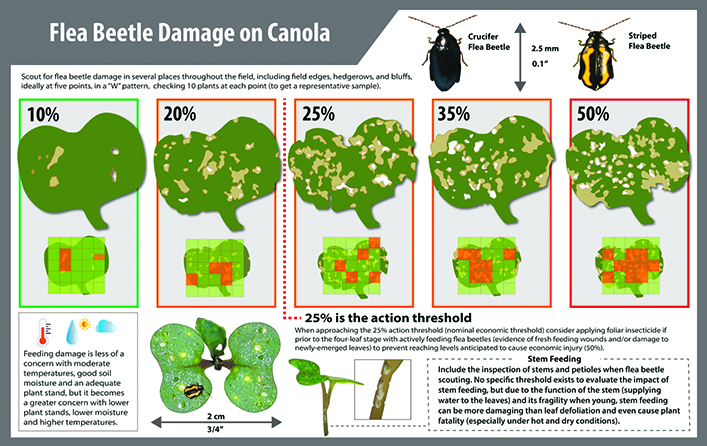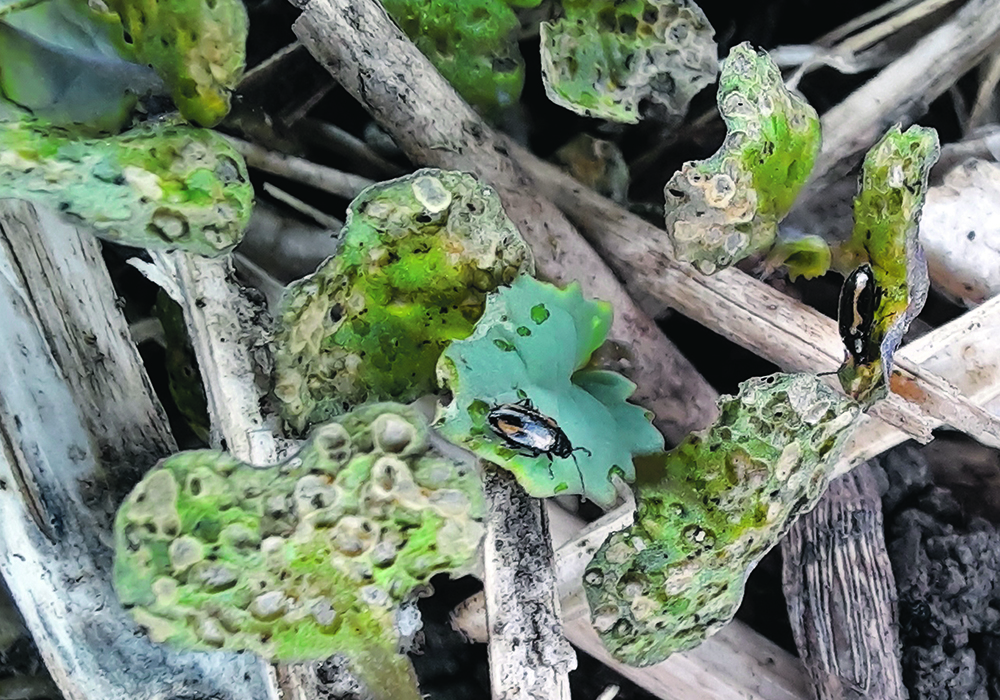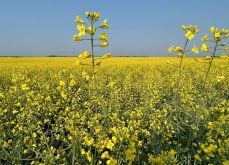Canola is expected to be seeded on about 21.7 million acres in Canada this year, so it’s not surprising that its greatest pest is back.
“I am getting some reports from north of Calgary, the Carrot River area (of Saskatchewan), southern Manitoba, that they’re seeing a fair number of flea beetles. But for the most part, those growers are reporting activity on volunteer canola or something other than their crop,” said Keith Gabert, agronomy specialist at the Canola Council of Canada.
Related flea beetle stories:
Substantial rains fell across large areas of the canola-growing region last week and that could help the situation. It means canola’s vulnerability period, up to the three- or four-leaf stage when flea beetles can do considerable damage, will be shortened because of favourable growing conditions.
“I sometimes joke that a half inch of rain solves most of your seeding problems and probably flea beetles, too, because if you can get that seed to emerge strongly, pick up the seed treatment and grow rapidly, typically we don’t have a problem,” Gabert said.
Tyler Wist, an Agriculture Canada research scientist who studies flea beetles, said dry conditions can negatively effect some seed treatments.
“If conditions are right, it (seed treatment) should last until the three- or four-leaf stage, so it should help those plants to outgrow the flea beetle attack,” Wist said.
“If it’s too dry, the neonics don’t really move up and into the plant very well, and so maybe the plants are not being protected nearly enough under the really dry conditions.”
He said young canola plants are also much more resilient under favourable moisture conditions, which growers should consider when deciding whether to spray the pest.
“Canola can take a lot of damage before you actually need to spray. The conditions that make me worried for flea beetles though, are the hot and dry conditions because that makes the flea beetle bites on the plants worse. When it’s hot and dry, the plant can’t compensate for having these holes in it and then the holes lead to increased drying,” Wist said.
“If you’ve got a good plant stand, you’ve got your insecticide treatment on the seeds, you’ve got decent moisture conditions, it’s not blisteringly hot and you’ve got a little bit of rain, those are all things that you should think about before you hop on the sprayer.”
The threshold for spraying for flea beetles is 25 percent damage on canola before the four-leaf stage.
No threshold exists to evaluate the impact of stem feeding, but because the stems are so important and fragile in young plants, stem feeding is considered more damaging than leaf feeding.
“In a project we ran, we found that you don’t take any yield damage until you hit about 45 percent damage average on your plant. So that 25 percent action threshold will keep you from getting up to the damage threshold where you start taking a yield loss, but you don’t get a yield loss at 25 percent damage, which was really cool to see,” Wist said.
Gabert said growers should anticipate that 25 percent threshold and be ready to act because flea beetles are fast.
“A catch line that I’m really pushing this year is that they should anticipate that 25 percent action threshold. Because if you have a lot of flea beetles and a struggling crop, the chances are that 25 percent action threshold will get passed and you’ll see damage,” Gabert said.
When considering a broad-spectrum application of an insecticide, growers should remember there are beneficial insects that attack flea beetles, including rove beetles, parasitoids and other species, Wist said.

Wist said he’s looking for ways to reduce the reliance on seed treatments, including one project that has canola seed with seed treatment on the outside of the field and untreated seed on the inside. The goal is to see if the outside treated canola plants can protect the untreated plants from flea beetles.
Because flea beetles come into fields from field edges, there may also be an opportunity to increase seeding rates around the field, so that when they start to feed, it’s more likely the crop damage will remain below the action threshold.
Gabert said if spraying is necessary, it might be possible to spray only spot areas where damage is the most severe, including field edges.
“In some instances, you’ll be able to see the flea beetles are moving from the edge of the field or perhaps even from last year’s canola, and a targeted spray around the edge of the field might actually be sufficient. Or, at least it might be the first step and then you come back in with an additional application,” Gabert said.
“But you do have to have conditions where the flea beetles are moving relatively slowly. So, if you have nice warm conditions, where the flea beetles can fly, which is usually above 14 C or 15 , they can get across the field before you really notice that edge effect.”
He said reseeding because of flea beetle damage is rare, and that growers should always keep crop insurance planting deadlines in mind.
“Regardless of the cause, if you have two well-established plants per sq. foot, in the case of flea beetles — plants that will survive through the insect feeding and infestation — you probably shouldn’t reseed,” Gabert said.
















